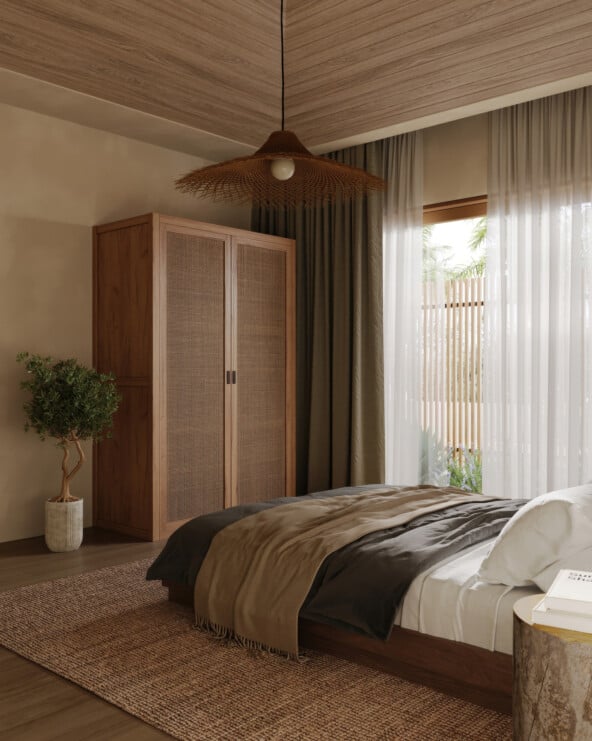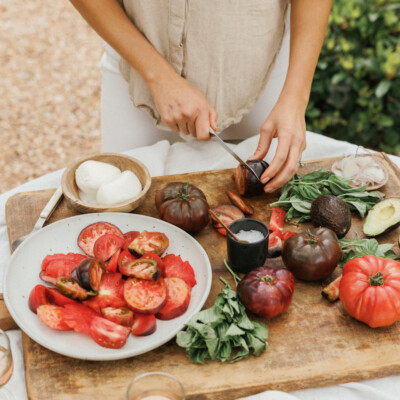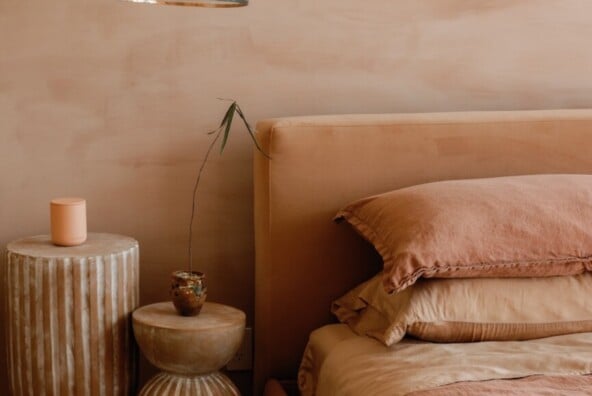We’ve all been there: a closet full of clothes with nothing to wear. Sure, we have that handful of staple pieces that we couldn’t possibly live without, but the rest of our wardrobes can go untouched for weeks, months, or even years. I personally found myself in a dire state of closet disrepair a few months ago, around the same time that I stumbled upon the super stylish blog, Un-Fancy. With her 37-piece wardrobe, Caroline inspired me and many others by proving that when it comes to fashion, less is definitely more. Lucky for us, Caroline is joining us today to share her tried and tested tips for building out a wardrobe that’s versatile, stylish and budget-friendly, giving you the peace of mind and freedom to focus on what really matters. Without further ado, take it away Caroline!
First, change the way you clean out your closet.
Usually, when it’s time to purge, we rifle through our clothes while they are still hung in our closet. But there’s a much better way — one that will actually help you find your style, and give you clarity…
Cleaning out your closet.
Step 1: The secret to cleaning out your closet is to completely empty your closet. I know, it sounds like a ton of work, but it works. Take absolutely everything out of your closet and lay it out on your bed.
Cleaning out your closet.
Step 2: Sort each item into one of these four piles:
Love it and would wear it right now – It fits. It’s right for your lifestyle. You feel comfortable and confident wearing it. Put it back in your closet.
Maybe – This is for items that don’t fit quite right. The color might be a little off, or it has sentimental value, or you’re keeping it because you paid a lot for it but don’t wear it. Put all this stuff in a box and store it in the garage. You can always go get stuff out of it, but you probably won’t. If it’s still in the box at the end of your season, it’s time to say goodbye.
Nope – Self explanatory. Donate, swap with a friend, or sell it to fund new purchases.
Seasonal – Wool coat in summer? Probably don’t need it handy, but you’d never get rid of a staple like that. If it’s not in season, but you love it, put it in a nice under-the-bed box and store it. You’ll definitely use it when the appropriate season rolls around.
Cleaning out your closet.
Step 3: Assess what’s left in your closet – your love it clothes. Your true style should be practically screaming at you. How do you feel about it? Need to supplement? Make a plan, and shop. Need to downsize? Put a few more items in your maybe box.
Now that you’ve simplified your closet, it’s keeping it simple that’s tricky. Here are some easy ways to keep your closet uncluttered…
Keeping your closet simple.
Step 1: Play with your hair and makeup instead.
If you want to play with your style, instead of going shopping, why not try teaching yourself a new hairstyle or new makeup technique? Satisfy that same need to feel new and improved by learning how to do a perfectly Pinterest-worthy messy braid.
Keeping your closet simple.
Step 2: Hit unsubscribe.
I can’t tell you how many times an email would convince me that I needed to go hit up that sale right this second. So I decided to unsubscribe from all the clothing email lists I was on. Yes, I missed news about fun sales. But I stopped caring. Contentment just felt better.
Keeping your closet simple.
Step 3: Try a capsule wardrobe.
Ever buy some fun new clothes, but end up wearing your old favorites anyway? Me too. Ever feel like you have nothing to wear, even when your closet is filled with clothes? Me too! I started wondering why I was spending money on and keeping a closet stuffed with mediocre clothes I didn’t love/wear.
So I tried out this capsule wardrobe idea I’d been hearing about. It’s basically a mini wardrobe made up of versatile pieces you completely love. There are a million different ways to try a capsule wardrobe, but here’s what I do: I limit my wardrobe to 37 pieces — tops, bottoms, shoes, and outerwear — and I dress with only these 37 pieces for 3 months. No shopping allowed.
Keeping your closet simple.
Step 4: Use the rule of 3.
Typically, when I start planning a wardrobe, I start with shoes since they make the biggest impact on an outfit. I like having about 9 pairs — for example, 3 pairs of flats, 3 pairs of heels, and 3 pairs of boots. For each of these sets, I include one classic pair, one fun statement pair, and one pair that falls between the two.
I like having 9 bottoms too – for example, 3 pairs of jeans, 3 pairs of shorts, and 3 skirts. Again, in these sets, I include a classic option, and statement piece, one option that falls between the two.
Then, I like having 15 tops. I bet you can guess where this is going. I’ll use the “Rule of Three” rule here too — for example: 3 sweaters, 3 tee shirts, 3 button up shirts, 3 tank tops, and 3 vests. All broken up into basics, statements, and in-betweens.
And finally, when it’s time to shop, shop smart.
Step 1: Ask yourself the right question.
When I’m trying to make a smart decision in the dressing room, I ask myself, “Would I reach for this over my chambray shirt?” I could wear chambray every single day, so if I couldn’t envision myself choosing this new top over my trusty staple, then I knew I’d never wear it – back on the rack it went. This little trick goes a long way in preventing shoppers remorse.
Try it for yourself: “Would I reach for this over my [insert favorite comparable piece of clothing here]?”
How to shop smart.
Step 2: Identify where you’d wear it.
You know the old shopping advice, “If you love it, get it”? I can’t tell you how many bad purchases I made following that advice. Loving it doesn’t mean it’ll fit into your lifestyle. And loving it in a dressing room doesn’t mean you’ll love it at a restaurant.
So get specific. Think of places, events, and times of the day. If you can’t envision yourself wearing it to your regular spots around town, put it back on the rack.
How to shop smart.
Step 3: Gather your pieces in an amazon wishlist before you buy.
Not only does this help you budget, but it helps determine if your pieces will work together as a whole. Here’s how I do it: About halfway through a season, I start window shopping for the next season. When I find pieces I think I want, I add them to my Amazon Wishlist with the universal button. When it’s time to start the next season, I make edits based on my budget and then purchase what’s left on the list.





Great post! I’ve been working towards the capsule wardrobe since the end of last year and it is amazing how fun and easy it makes getting ready each day. I feel more put together than I ever have. The tips on under-bed storage for those off-season and big ticket items I’m not quite ready to part with are really helpful.
I love the “9 shoes” idea and I’m gonna work on it ! Thanks for this helpful post.
I am so tempted to count the number of items in my wardrobe. Will definitely do that over weekend (smile).
This is amazing! I needed to read this years ago! Cleaning out my closet now, and trying her technique to have a closet full of ONLY things I’ll love and wear, and to shop smarter!
http://www.littleblackshell.com
Such a great read – thank you! I am just in the process of clearing out my wardrobe and am def going to follow these steps x
http://www.yellowpeachesblog.com
Fantastic article. I’m moving in to a new place next weekend and once I do my unpack, I’ll be going through my closet again!
I absolutely loved this post. I am trying to be more intentional with my clothing purchases. These are great ideas for implementing an intentional wardrobe. Thanks!
This is an excellent post, especially the capsule collection suggestion. One thing that wasn’t mentioned was looking for apparel that has more than one function. I like to create a capsule of one top, two pants, one jacket and one skirt that all mix and match seamlessly….the kicker here is that this capsule has two functions. Each item has design elements from the fashion runway so that it can be worn as stand alone fashion with heels, jewelry and scarves. The other function is high performance fitness apparel. How does this work? It only works if the fabrics, trims, and zippers are of catwalk quality but has all the technical attributes for the studio. There are very few brands that do this with true design elements from the runway that also function from am to pm, from work to workout or from boardroom to locker room. If you look, you’ll find them.
First time I “heard” about capsule wardrobe, but loved the idea, will work on mine!
I love, love, love this! Being a newly wed, I need to save up money, but I love shopping. This will help me stop over spending on clothes I just don’t need.
cool closet
http://thepocketstyle.blogspot.com/
Excellent suggestions I have way too many clothing and need to downside. I think I will swap it.
So what do you wear when your one ‘inbetween’ top is dirty? How often do you wash your jeans? This is unworkable for a normal life.
Great post! Very inspiring!
http://justsem.wordpress.com/
This is a must-read for every girl/woman! I’m going to do this right away. Up to my room then!
http://www.eliseschoice.wordpress.com
As always, some great advice! Will be trying my best to follow it.
Holly Sparkle | Petite Fashion & Lifestyle Blog
Awesome post, very helpful! Thank you for sharing 🙂
I really love your tips, really helpful ! 🙂
Caroline is the best!!! This is a great overview of her philosophy. She’s the sweetest.
This is the most comprehensive how-to I have read on simplifying a wardrobe and I appreciate it for that! I’m currently changing myself to minimize the amount of pieces in my wardrobe, and maximizing the ones I love the most. Thanks for these tips!
great article! Super helpful tips. Inspired me to clean out my closet the very day I read this post. My closet has never looked better!
Love the idea of boxing up the maybes! So many of them sit in my closet anyway. And, when I wear them I am not that jazzed about them so why not box them up! This post is actually the most useful one I have read out of the many posts I have read about streamlining my wardrobe. Thanks so much.
I really wish your site was more mobile friendly. This content seems great, but sadly it doesn’t scroll properly on mobile. In the gallery, it just gets stuck when trying to scroll to see more of post.
What about dresses?
“a closet full of clothes with nothing to wear” You can say this again! I’ll you tips on how to keep the closet simple with stylish wearable, rather with clutters of clothing that simply fill the space.
WoW! Amazing helpful post. I always find myself in front of my wardrobe thinking “I have nothing to wear” (who hasn’t ) I especially like the capsule wardrobe. Definitely gonna try it.
Bisous Marye,
http://www.niniiinjune.com
I love that black fringe sweater! Where can I find it? Thanks 🙂
Only 9 pairs of shoes? I’m scared to get rid of my precious 😉
This is amazing, great advice. I really need to do this I struggle with what to wear all the time!
http://www.spacedreamsandmarshmallows.blogspot.com
Brilliant!!!
great tips ! very useful ! love that post!
http://nurielfashion.blogspot.co.il/2015/02/hello-everyone-it-has-been-exhausting.html?showComment=1425405912863#c7296822523858593396
UGH This is brilliant! I have been putting off going through my wardrobe for weeks, now. It’s so intimidating and the prospect of tossing something I may want later… daunting!! This is a great way to break it down and really leave yourself with the perfect assortment!!
Silvia: I will try your technique .
I’ve read a lot of capsule wardrobe articles, but the point on slide 11 is great! It’s so true, there’s plenty of pieces I love, but will I love it for every day wear? Not always. Great tips! Think i’ll be doing a wardrobe clear out soon, especially being a new mum! 🙂
I have been doing a capsule wardrobe, minimalist for sure. The rule of 33, clothes, jackets, shoes, purse/accessories. I have a few dresses for special occasion and since I live in the bay area where weather can run between cold and hot any time of the year, I have all seasons together. If I buy anything new, I have to remove an item from my capsule so I really have to need it or I can’t buy it. Works great, dressing and packing are a dream
The first thing I do when I begin working with a client is tackle the dreaded closet. Before I arrive and to streamline the process. http://cuteactivewear.blogspot.com/